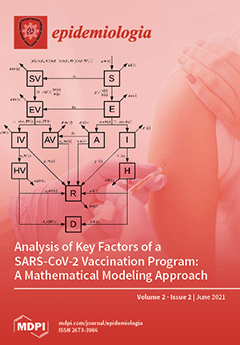This study quantifies the transmission potential of SARS-CoV-2 across public health districts in Georgia, USA, and tests if per capita cumulative case count varies across counties. To estimate the time-varying reproduction number,
Rt of SARS-CoV-2 in Georgia and its 18 public health
[...] Read more.
This study quantifies the transmission potential of SARS-CoV-2 across public health districts in Georgia, USA, and tests if per capita cumulative case count varies across counties. To estimate the time-varying reproduction number,
Rt of SARS-CoV-2 in Georgia and its 18 public health districts, we apply the R package ‘EpiEstim’ to the time series of historical daily incidence of confirmed cases, 2 March–15 December 2020. The epidemic curve is shifted backward by nine days to account for the incubation period and delay to testing. Linear regression is performed between log
10-transformed per capita cumulative case count and log
10-transformed population size. We observe
Rt fluctuations as state and countywide policies are implemented. Policy changes are associated with increases or decreases at different time points.
Rt increases, following the reopening of schools for in-person instruction in August. Evidence suggests that counties with lower population size had a higher per capita cumulative case count on June 15 (slope = −0.10,
p = 0.04) and October 15 (slope = −0.05,
p = 0.03), but not on August 15 (slope = −0.04,
p = 0.09), nor December 15 (slope = −0.02,
p = 0.41). We found extensive community transmission of SARS-CoV-2 across all 18 health districts in Georgia with median 7-day-sliding window
Rt estimates between 1 and 1.4 after March 2020.
Full article






